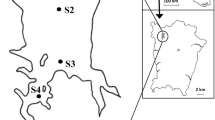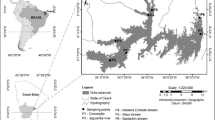Abstract
During July 2004, various limnological characteristics of 24 floodplain lakes and reservoirs have been explored along the Middle Daugava for the first time in order to reveal possible impact of the long-term mean annual flooding frequency on their phytoplankton, zooplankton, macrozoobenthos and macrophyta communities. Obtained data series were analysed by Spearman’s rank correlation method, Principal Component Analysis (PCA) method and Renkonen’s similarity test. UPMGA method was used for single linkage clustering of the lakes based on the abundance of phyto- and zooplankton taxa. Low similarity between the obtained cluster trees and hydrological grouping was stated indicating minor impact of the flooding hydrology on summer plankton communities of these lakes. Significant correlation between the flooding frequency and several physicochemical and biological parameters was found. Six main factors, which explain observed variations, were extracted by PCA. Significant negative impact of hydrological connectivity on zooplankton species diversity as well as positive impact on Oligochaeta density was stated, whereas other biotic parameters were affected by local factors, such as lake morphology, internal loading of nutrients from sediments, throphic interactions as well as local source of dissolved organic matter.







Similar content being viewed by others
References
Briede, A., I. Kokorīte, M. Kļaviņš & I. Druvietis, 2005. Daugava River case study – Latvia. In Modelling Nutrient Loads and Response in River and Estuary Systems. NATO/CCMS Pilot study. Final Report. North Atlantic Treaty Organization, 223–256.
Druvietis, I., 1998. Observations on cyanobacteria blooms in Latvia’s inland waters. In Reguera, B., I., Blanco, M. L., Fernández & T. Wyatt (eds), Harmful Algae. Xunta de Galicia, Intergovernmental Oceanographic Commission of UNESCO, 35–36.
Fott, B., 1971. Algenkunde. 2. auflage. Veb Gustav Fisher Verlag, Jena.
Furch, K. & W. J. Junk, 1993. Seasonal nutrient dynamics in an Amazonian floodplain lake. Archiv für Hydrobiologie 128: 277–285.
Gruberts, D., 2003. The four largest floodplain lakes in Latvia: hydrology, hydrochemistry and hydrobiology. In Järvet, A. & E. Lode (eds), Ecohydrological Processes in Northern Wetlands. Selected papers. Tartu University Press, Tallinn, 196–202.
Gruberts, D. & I. Druvietis, 2001. Phytoplankton periodicity in floodplain lake Grivas, Latvia – Baltic State. In Partnerships for Sustainable Life in Lake Ecosystems. Proceedings of the 9th International Conference On The Conservation And Management Of Lakes. BIWAKO, Shiga, 54–57.
Gruberts, D., I. Druvietis & M. Kļaviņš, 2005. Seasonal variability of aquatic chemistry and phytoplankton communities in a shallow floodplain lake of the Daugava River, Latvia. Ecohydrology and Hydrobiology 5(2): 155–164.
Hein, T., C. Baranyi, G. Heiler, C. Holarek, P. Riedler & F. Schiemer, 2001. Plankton communities controlled by hydrology in two Danubian floodplain segments and the River Danube, Austria. Verhandlungen International Verein für Limnologie 27, 1–2.
Huszar, V. L. D. & C. S. Reynolds, 1997. Phytoplankton periodicity and sequences of dominance in an Amazonian floodplain lake (Lago-Batata, Para, Brazil) – responses for gradual environmental change. Hydrobiologia 346: 169–181.
Junk, W. J., 1997. The Central Amazon Floodplain: Ecology of a Pulsing System. Springer-Verlag, New York.
Junk, W. J., P. B. Bayley & R. E. Sparks, 1989. The flood pulse concept in river-floodplain systems. In Dodge, D. P. (ed.), Proceedings of the International Large River Symposium. Canadian Special Publication on Fisheries and Aquatic Sciences, 106: 110–127.
Katelo, I., 1995. Eutrophication process in Lake Stropu, Latvia. Proceedings of the Latvian Academy of Sciences 573: 101–104.
Kirk, K. L. & J. J. Gilbert, 1990. Suspended clay and the population dynamics of planktonic rotifers and cladocerans. Ecology 71: 1741–1755.
Klaviņš, M. & P. Cimdiņš, 2005. Water Quality and its Protection. University of Latvia, Riga (in Latvian).
Krebs, C. J., 1989. Ecological Methodology. Harper Collins Publishers.
Kumsare, A., 1967. Gidrobiologija reki Daugava [Hydrobiology of the Daugava River]. Zinatne, Riga.
Lesack, L. F. W. & J. M. Melack, 1995. Flooding hydrology and mixture dynamics of lake water derived from multiple sources in an Amazon floodplain lake. Water Resources Research 31: 329–345.
Lewis, W. M., S. J. Hamilton, M. A. Lasi, M. Rodríguez & J. F. Saunders III, 2000. Ecological determinism on the Orinoco floodplain. BioScience 50: 681–692.
Muylaert, K. & W. Vyverman, 2006. Impact of a flood event on the planktonic food web of the Schelde estuary (Belgium) in spring 1998. Hydrobiologia 559(1): 385–394.
Račinskis, E., 2004. Important Bird Areas of European Union Importance in Latvia. Latvian Ornithological Society, Riga.
Reynolds, C. S., 1993. The Ecology of Freshwater Phytoplankton. University Press, Cambridge.
Roozen, F. C. J. M., G. J. Geest, B. W. Ibelings, R. Roijackers, M. Scheffer & A. D. Buijse, 2003. Lake age and water level affect the turbidity of floodplain lakes along the lower Rhine. Freshwater Biology 48: 519–531.
Roozen, F. C. J. M., 2005. Transparency of floodplain lakes; a study of plankton and suspended mater along the lower Rhine. Doctoral thesis. Wageningen Universiteit.
Scheffer, M., 2004. Ecology of Shallow Lakes. Kluwer Academic Publishers, Dordrecht.
Stemberger, R. S. & M. S. Evans, 1984. Rotifer seasonal succession and copepod predation in Lake Michigan. Journal of Great Lakes Research 10(4): 417–428.
Tockner, K., F. Malard & J. V. Ward, 2000. An extension of the flood pulse concept. Hydrological Processes 14: 2861–2883.
Utermöh, H., 1958. Zur Vervollkomnung der quantitativen Phytoplankton-Methodik. Mitt International Ver Theoretical and Applied Limnology 19: 100–124.
Van den Brink, F. W. B. & G. Van der Velde, 1994. Impact of hydrology and water chemistry on floodplain lake communities along the lower Rhine and Meuse. Water Science and Technology 29: 57–60.
Van den Brink, F. W. B., M. M. Van Katwijk & G. Van der Velde, 1994. Impact of hydrology on phyto- and zooplankton community composition in floodplain lakes along the lower Rhine and Meuse. Journal of Plankton Research 16: 351–373.
Wetzel, R. G. & G. E. Likens, 1991. Limnological Analyses, 2nd edn. Springer-Verlag, New York.
Acknowledgements
This study has been supported by VPD1/ESF/PIAA/04/NP/3.2.3/0003/0065 project. The authors would like to thank Ecological Laboratory of Daugavpils Regional Environment Board for preparing chemical analysis of water samples.
Author information
Authors and Affiliations
Corresponding author
Rights and permissions
About this article
Cite this article
Gruberts, D., Druvietis, I., Parele, E. et al. Impact of hydrology on aquatic communities of floodplain lakes along the Daugava River (Latvia). Hydrobiologia 584, 223–237 (2007). https://doi.org/10.1007/s10750-007-0587-8
Issue Date:
DOI: https://doi.org/10.1007/s10750-007-0587-8




